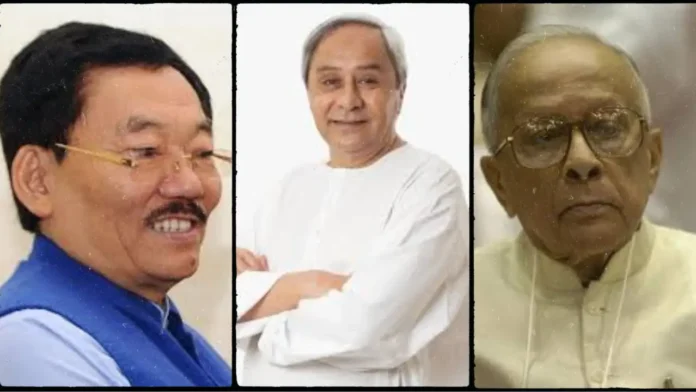Chief Ministers hold one of the most influential political positions in India. Their leadership defines the development, stability, and socio-economic direction of their states. While many politicians have headed state governments, only a select few have managed to remain in power for decades, earning a place in history.
As Bihar witnesses yet another government formation with Nitish Kumar poised for another term, it’s the perfect time to look at the longest-serving Chief Ministers in India—leaders whose tenure reflects political consistency, public trust, and long-lasting governance.
Here’s a deep look at the top 10 longest-serving CMs in Indian history, their contributions, their challenges, and their legacy.
1. Pawan Kumar Chamling – Sikkim
Tenure: 24+ Years (December 1994 – May 2019)**
Pawan Kumar Chamling stands as India’s longest-serving Chief Minister, leading Sikkim for nearly 25 years without interruption.
He won five consecutive terms, a political record that showcases his strong public support and stable governance.
Key Contributions:
- Transformed Sikkim into India’s first 100% organic state
- Strengthened tourism and eco-friendly policies
- Maintained one of India’s most peaceful law-and-order environments
Chamling’s long rule reflects consistency and a leadership style rooted in development and environmental sustainability.
2. Naveen Patnaik – Odisha
Tenure: 24 Years (March 2000 – June 2024)**
Naveen Patnaik is one of India’s most respected political figures. Leading Odisha for 24 years, he modernized the state with reforms in disaster management, women’s empowerment, and public welfare.
Key Contributions:
- Global recognition for Odisha’s disaster management model
- Mission Shakti: Empowering millions of women through SHGs
- Development of infrastructure and social welfare programs
Patnaik narrowly missed becoming India’s longest-serving CM after losing the 2024 elections, ending a remarkable two-decade tenure.
3. Jyoti Basu – West Bengal
Tenure: 23 Years (1977 – 2000)**
Jyoti Basu, a towering figure of Indian politics, served as West Bengal’s Chief Minister for over 23 years.
He led one of the world’s longest-serving communist governments and was known for his political depth and administrative stability.
Key Highlights:
- Pioneered land reforms under “Operation Barga”
- Strengthened workers’ rights
- Declined the Prime Minister’s post, calling it a “historic blunder” by his party
Basu remains one of India’s most iconic leaders.
4. Gegong Apang – Arunachal Pradesh
Tenure: 22 Years (Two Separate Terms)**
Gegong Apang dominated Arunachal Pradesh politics through two long-standing tenures—first from 1980 to 1999, and later from 2003 to 2007.
Highlights:
- Built political stability in a geographically challenging state
- Focused on rural development and tribal welfare
- Remained the face of Arunachal politics for decades
His cumulative 22 years make him one of India’s political stalwarts.
5. Lal Thanhawla – Mizoram
Tenure: 22 Years (Across Multiple Terms)**
Lal Thanhawla served Mizoram as Chief Minister across three separate periods, guiding the state through reform and modernization.
Contributions:
- Expanded road connectivity in a hilly region
- Strengthened healthcare and education
- Helped maintain peace and developmental pace
His leadership left a deep imprint on Mizoram’s governance.
6. Virbhadra Singh – Himachal Pradesh
Tenure: 21 Years (Multiple Terms)**
Often called the “Raja Saab” of Himachal Pradesh, Virbhadra Singh served six terms as Chief Minister.
His Legacy Includes:
- Expanding road networks in remote hill districts
- Boosting tourism infrastructure
- Strengthening the education sector
His influence defined Himachal’s political landscape for generations.
7. Manik Sarkar – Tripura
Tenure: 19+ Years (1998 – 2018)**
Known as India’s “cleanest and simplest politician,” Manik Sarkar led Tripura for 20 years.
A CPI(M) veteran, he personally lived a minimalist lifestyle and donated most of his salary to the party.
Strengths:
- Improved literacy and health indicators
- Brought stability and reduced insurgency
- Focused on welfare for tribal communities
Sarkar remains a respected figure nationally.
8. Nitish Kumar – Bihar
Tenure: 19+ Years (2000 – Present)**
Nitish Kumar’s political journey is one of the most dynamic in Indian politics. Having served nine separate terms, he is Bihar’s longest-serving Chief Minister.
Noteworthy Contributions:
- Improved Bihar’s road transport and electricity sectors
- Transformed education with cycles and uniforms for girls
- Strengthened law and order after decades of instability
His continuous return to power reflects a strong public connection and administrative credibility.
9. M. Karunanidhi – Tamil Nadu
Tenure: 18 Years (Across Five Terms)**
Fondly known as “Kalaignar,” M. Karunanidhi was not only a political leader but also a literary giant.
Major Achievements:
- Advocated for social justice and Dravidian ideology
- Improved public welfare schemes
- Played a crucial role in Tamil cultural preservation
His political influence shaped Tamil Nadu’s identity.
10. Parkash Singh Badal – Punjab
Tenure: 18 Years (Across Four Terms)
Parkash Singh Badal was one of Punjab’s most influential Sikh leaders and among India’s youngest Chief Ministers when he first took charge.
His Tenure Focused On:
- Strengthening agriculture
- Improving rural infrastructure
- Enhancing religious and cultural institutions
Badal remains a towering figure in Punjab’s political history.
Conclusion
India’s longest-serving Chief Ministers are more than just political figures—they are architects of regional transformation.
Their decades-long leadership reflects:
- Public trust
- Electoral strength
- Vision for governance
- Stability in a complex democracy
From Pawan Chamling’s record-setting tenure in Sikkim to Nitish Kumar’s dynamic leadership in Bihar, these leaders have shaped the social, economic, and political landscape of their states.
As India evolves, their legacies continue to influence governance models and political strategies across the nation.
